Related Research Articles

Benjamin David Goodman was an American clarinetist and bandleader known as the "King of Swing".
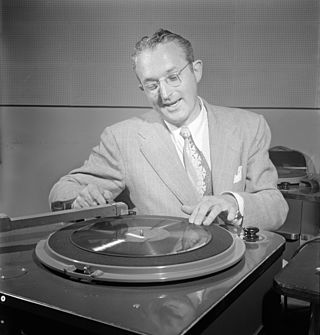
Thomas Francis Dorsey Jr. was an American jazz trombonist, composer, conductor and bandleader of the big band era. He was known as the "Sentimental Gentleman of Swing" because of his smooth-toned trombone playing. His theme song was "I'm Getting Sentimental Over You". His technical skill on the trombone gave him renown among other musicians. He was the younger brother of bandleader Jimmy Dorsey. After Dorsey broke with his brother in the mid-1930s, he led an extremely successful band from the late 1930s into the 1950s. He is best remembered for standards such as "Opus One", "Song of India", "Marie", "On Treasure Island", and his biggest hit single, "I'll Never Smile Again".
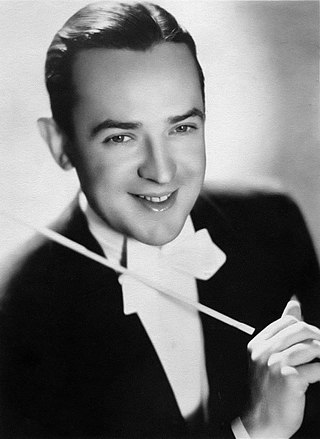
James Francis Dorsey was an American jazz clarinetist, saxophonist, composer and big band leader. He recorded and composed the jazz and pop standards "I'm Glad There Is You " and "It's The Dreamer In Me". His other major recordings were "Tailspin", "John Silver", "So Many Times", "Amapola", "Brazil ", "Pennies from Heaven" with Bing Crosby, Louis Armstrong, and Frances Langford, "Grand Central Getaway", and "So Rare". He played clarinet on the seminal jazz standards "Singin' the Blues" in 1927 and the original 1930 recording of "Georgia on My Mind", which were inducted into the Grammy Hall of Fame.
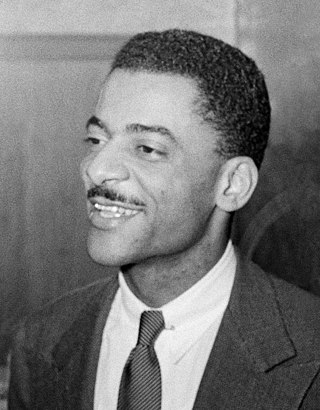
Theodore Shaw Wilson was an American jazz pianist. Described by critic Scott Yanow as "the definitive swing pianist", Wilson's piano style was gentle, elegant, and virtuosic. His style was highly influenced by Earl Hines and Art Tatum. His work was featured on the records of many of the biggest names in jazz, including Louis Armstrong, Lena Horne, Benny Goodman, Billie Holiday, and Ella Fitzgerald. With Goodman, he was one of the first black musicians to perform prominently alongside white musicians. In addition to his extensive work as a sideman, Wilson also led his own groups and recording sessions from the late 1920s to the 1980s.
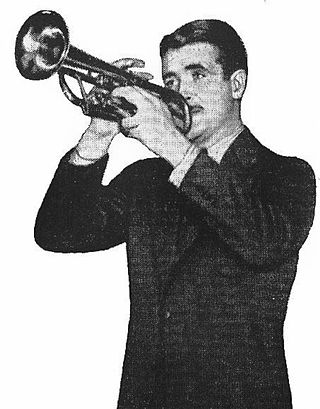
Roland Bernard "Bunny" Berigan was an American jazz trumpeter and bandleader who rose to fame during the swing era. His career and influence were shortened by alcoholism, and ended with his early demise at the age of 33 from cirrhosis. Although he composed some jazz instrumentals such as "Chicken and Waffles" and "Blues", Berigan was best known for his virtuoso jazz trumpeting. His 1937 classic recording "I Can't Get Started" was inducted into the Grammy Hall of Fame in 1975.

Boniface Ferdinand Leonard "Buddy" DeFranco was an Italian-American jazz clarinetist. In addition to his work as a bandleader, DeFranco led the Glenn Miller Orchestra for almost a decade in the 1960s and 1970s.
The swing era was the period (1933–1947) when big band swing music was the most popular music in the United States. Though this was its most popular period, the music had actually been around since the late 1920s and early 1930s, being played by black bands led by such artists as Duke Ellington, Jimmie Lunceford, Bennie Moten, Cab Calloway, Earl Hines, and Fletcher Henderson, and white bands from the 1920s led by the likes of Jean Goldkette, Russ Morgan and Isham Jones. An early milestone in the era was from "the King of Swing" Benny Goodman's performance at the Palomar Ballroom in Los Angeles on August 21, 1935, bringing the music to the rest of the country. The 1930s also became the era of other great soloists: the tenor saxophonists Coleman Hawkins, Ben Webster and Lester Young; the alto saxophonists Benny Carter and Johnny Hodges; the drummers Chick Webb, Gene Krupa, Jo Jones and Sid Catlett; the pianists Fats Waller and Teddy Wilson; the trumpeters Louis Armstrong, Roy Eldridge, Bunny Berigan, and Rex Stewart.

Charles James Shavers was an American jazz trumpeter who played with Dizzy Gillespie, Nat King Cole, Roy Eldridge, Johnny Dodds, Jimmie Noone, Sidney Bechet, Midge Williams, Tommy Dorsey, and Billie Holiday. He was also an arranger and composer, and one of his compositions, "Undecided", is a jazz standard.

Urban Clifford "Urbie" Green was an American jazz trombonist who toured with Woody Herman, Gene Krupa, Jan Savitt, and Frankie Carle. He played on over 250 recordings and released more than two dozen albums as a soloist. He was inducted into the Alabama Jazz Hall of Fame in 1995.

Enoch Henry Light was an American classically trained violinist, danceband leader, and recording engineer. As the leader of various dance bands that recorded as early as March 1927 and continuing through at least 1940, Light and his band primarily worked in various hotels in New York. For a time in 1928 he also led a band in Paris. In the 1930s Light also studied conducting with the French conductor Maurice Frigara in Paris.

James Mundell Lowe was an American jazz guitarist who worked often in radio, television, and film, and as a session musician.

Dave Tough was an American jazz drummer associated with Dixieland and swing jazz in the 1930s and 1940s.
"King Porter Stomp" is a jazz standard by pianist Jelly Roll Morton, first recorded in 1923. The composition is considered to be important in the development of jazz. It became a hit during the swing era, when it was recorded by Benny Goodman.

Georgie Auld was a jazz tenor saxophonist, clarinetist, and bandleader.

Lawrence Joseph Elgart was an American jazz bandleader. With his brother Les, he recorded "Bandstand Boogie", the theme to the long-running dance show American Bandstand.
Daniel Bernard Bank was an American jazz saxophonist, clarinetist, and flautist. He is credited on some releases as Danny Banks.
Walt Levinsky was an American big band and orchestral player, composer, arranger, and bandleader. While many of his big band assignments were as lead alto sax player, his favorite instrument was the clarinet.

This Is Tommy Dorsey & His Orchestra, Vol. 1 is the first of two volumes originally released in a 1971 series by RCA Victor, which was created in response to a resurgence in big band recreations during the late '60s and early '70s, and is a reissue of 20 famous recordings by Tommy Dorsey & His Orchestra. The album was subsequently re-released in 2001 by Collectables Records.

"Candlelights" is a 1930 jazz composition for solo piano by cornetist Bix Beiderbecke. It was the second in the series of four piano works which Bix Beiderbecke composed during his career.
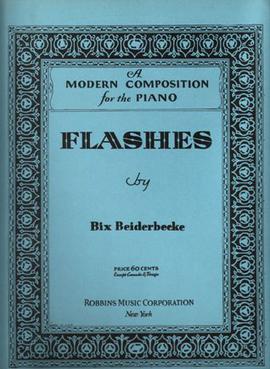
"Flashes" is a 1931 jazz composition for solo piano by cornetist Bix Beiderbecke. It is the third work in a series of four compositions for piano composed by Bix Beiderbecke during his career.
References
- 1 2 3 4 Lee, William. People in Jazz: Jazz Keyboard Improvisors of the 19th & 20th century. pp. 76
- ↑ Nicholson, Stuart (2017). Jazz: A Beginner's Guide. Oneworld. ISBN 978-1780749983.
- 1 2 3 4 5 Schuller, Gunther (1989). The swing era: The development of jazz, 1930-1945. New York/London: Oxford University Press. pp. 474–475, 495–496, 650–651, 673, 694, 756–759. ISBN 9780195043129.
- ↑ Firestone, Ross (1993). Swing, swing, swing: the life & times of Benny Goodman. Norton. p. 109. ISBN 9780393033717.
- ↑ Giddins, Gary (2000). Visions of jazz : the first century. Oxford University Press. p. 207. ISBN 9780195132410.
- 1 2 3 Dupuis, Robert (2005). Bunny Berigan: Elusive Legend of Jazz. Louisiana State University Press. p. 167. ISBN 9780807130681.
- ↑ Sullivan, Steve (2013). Encyclopedia of great popular song recordings. Scarecrow Press. p. 185. ISBN 9780810882959.
- ↑ "Music - Popular". Time. 9 January 1939.
- ↑ Simon, George T. (2012). The Big Bands (4th ed.). Schirmer Books. ISBN 978-0028724300.
- ↑ Kirchner, Bill, ed. (2005). The Oxford Companion to Jazz. Oxford University Press. p. 289. ISBN 978-0195183597.
- ↑ Gourse, Leslie (2009). Sassy: The Life of Sarah Vaughan. Hachette. p. 59.
- ↑ Friedwald, Will (2020). Straighten Up and Fly Right: The Life and Music of Nat King Cole. Oxford University. p. 147.
- ↑ Hulme, George (2008). Mel Torme: A Chronicle of His Recordings, Books, and Films. McFarland. p. 33.
- ↑ MGM Wins Race on 'High, Mighty' Platter Releases. Nielsen. 29 May 1954. pp. 32–. Retrieved 14 May 2020.
- ↑ Ratlifff, Ben (2002). Jazz: A Critic's Guide to the 100 Most Important Recordings. New York: Time. p. 77.
- 1 2 Vail, Ken (1996). Bird's Diary: The Life of Charlie Parker 1945–1955. Castle Communications. pp. 79, 108.
- ↑ Yanow, Scott (2000). Bebop. San Francisco: Miller Freeman. p. 49.
- ↑ Gitler, Ira. The Masters of Bebop. Hachette. p. 46.
- ↑ Knauer, Wolfram (2014). Charlie Parker. Reclam Verlag.
- ↑ Kutner, Jon; Spencer, Leigh (2010). 1000 UK Number One Hits. Omnibus.
- ↑ Lowry, Cynthia (21 February 1963). "Weary Perry Como Sets Limit of 6 Shows Next Year". Schenectady Gazette. Retrieved 7 June 2010.
- 1 2 Joseph Lipman - Emmys, credits, Music Department, The Hollywood Place